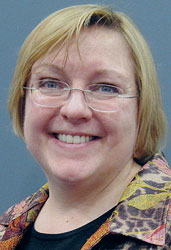SIDEBAR: The hSPAWN Algorithm

Return to main Working Papers article: "Peer-to-Peer Cooperative Positioning: Part II"
By Inside GNSS
Return to main Working Papers article: "Peer-to-Peer Cooperative Positioning: Part II"
By Inside GNSSIn the 1974 Mel Brooks’ movie, Blazing Saddles, one of the characters — surrounded by his enemies — points a gun at his head and tries to escape by taking himself hostage.
As I recall, he gets away with the absurd move and survives to fight another day. That’s Hollywood!
By Dee Ann Divis
Members of Congress — who have not finished next year’s appropriations, face half a dozen major tax and program fixes set to expire, and have their own re-elections to worry about — must quickly decide how to handle a tsunami of federal budget cuts that experts say could sweep the economy back into recession.
By Dee Ann Divis
Q: What are the tradeoffs between using L1-only and L1+L2 for PPP?
A: Precise point positioning (PPP) is a technique that can compute positions with a high accuracy anywhere on the globe using a single GNSS receiver. It relies on highly accurate satellite position and clock data that can be downloaded from the International GNSS Service (IGS) or obtained in real-time from a number of service providers, using either the Internet or satellite links.
By Inside GNSSReturn to main article: "How do GNSS-derived heights differ from other height systems?"
By Inside GNSSAs Desi Arnaz often said to Lucille Ball during an “I Love Lucy” episode on TV, “You’ve got some ’splaining to do.”
I refer, of course, to the untoward and unexpected initiative by the British Ministry of Defense (MoD) to patent the technical innovations that underlie the planned next generation of civil GNSS signals.
By Dee Ann DivisReturn to main Washington View article: "USPTO Nears Approval of Troubling British Patent on New GPS Civil Signal"
By Dee Ann Divis FIGURE 2: Example of a national geoid (upper diagram) and a correction surface for the transformation from the new orthometric height system to the old height system (lower diagram). Country is Switzerland. Geoid undulations range from 45 to 55 meters in ETRS89 and from -5 to +5 meters in the national System CH1903+. Lower diagram: Correction surface to transform from the new orthometric height system (LHN95) to the old height system LN02 with corrections from -0.10 to 0.55 meters.
FIGURE 2: Example of a national geoid (upper diagram) and a correction surface for the transformation from the new orthometric height system to the old height system (lower diagram). Country is Switzerland. Geoid undulations range from 45 to 55 meters in ETRS89 and from -5 to +5 meters in the national System CH1903+. Lower diagram: Correction surface to transform from the new orthometric height system (LHN95) to the old height system LN02 with corrections from -0.10 to 0.55 meters.Q: How do GNSS-derived heights differ from other height systems?
A: Height estimation using GNSS always seems to be trickier than horizontal coordinate estimation.
Why?
On the one hand, the GNSS technique has error sources that are more critical in the vertical direction. Height estimates are weaker because of a combination of satellite geometry, the presence of strong correlations to other parameters, such as atmospheric delays, and the antenna phase center model applied during data analysis.
By Inside GNSSWorking Papers explore the technical and scientific themes that underpin GNSS programs and applications. This regular column is coordinated by Prof. Dr.-Ing. Günter Hein, head of Europe’s Galileo Operations and Evolution.
By Inside GNSSReturn to main article: "Peer-to-Peer Cooperative Positioning"
By Inside GNSSReturn to main article: "Peer-to-Peer Cooperative Positioning"
By Inside GNSS